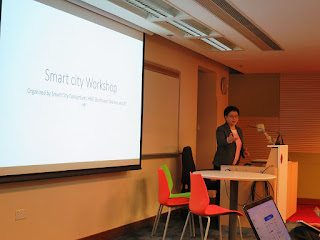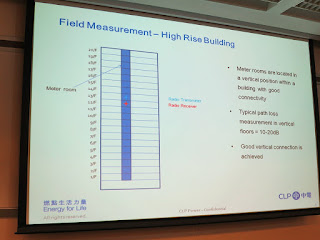The Smart City Workshop 2016 was
coorganized by HKIE Electronics Division and Wireless Sustainability Center,
Department of Electronics, City University of Hong Kong held on 5 September
2016. Supporting organizations included Smart City
Consortium (SCC), IET Hong Kong, IEEE CE Chapter and CIE Hong Kong. The development of smart city has become a
key item for many countries around the world.
This workshop had gathered experts from Portugal and Hong Kong to
discuss about the development of smart city, in particular in the aspect of intelligent
transportation, smart energy and smart mobility. In the beginning, Dr. KF Tsang (Chairman,
HKIE-EE) gave an opening speech.
Then Dr. Winnie Tang (Co-Founder,
Smart City Consortium) gave welcome speech.
She said Hong Kong was behind for long time. Recently, our government wake up and proposed
EKEO “Smart City @ Kowloon East”, as well as, OGCIO invited consultant to draft
Smart City Blueprint 2030 for Hong Kong.
The first speaker was Dr. Susana
Sargento (Associate Professor, Leader in Network Architectures and Protocols
(NAP) group, University of Aveiro and the Institute of Telecommunications) and
her topic entitled “Vehicular Mesh Network for Mobile Internet Access and the
Internet of Things”. She said Smart City implied Connected City that turn cars,
boats, bicycles, drones into mobile WiFi hotspots network in the roads, cycle
lanes, river, air so as to connect everything!
Dr. Sargento introduced the
vehicular networks and network mechanisms (GPS + IEEE 802.11p + WiFi + GPRS +
3G/4G) through multi-hop vehicular mesh networking. One of pilot in the City of Porto was
described.
Another example was Harbor
Network which connected trucks, cars, tow boats and vessels. There were 25 trucks, Tow boats, Patrol
vessels, Road side units, plug & play units for vehicles and wireless
coverage larger than 600m. The movie
video demonstration was showed.
Then the analysis of city pilot
internet and network results was discussed.
It found that download data was much higher than upload data during
traffic. It was knowledge of a city
which included vehicles results and bus/fleet information.
Finally, vehicles as Data Mules
and sensors had different functions involving environmental data analysis. In near future, all connected information
included self-driving cars, emergency communication, waste management,
real-time information of transportation, smart metering, remote sensing &
control, smart agriculture park, large scale events, aeronautic communication,
B2B & M2M communication, smart Tourism, etc.
Dr. Paulo Pedreiras (Assistant
Professor at the Electronics, Telecommunications and Informatics Department of
the University of Aveiro) and his presentation named “Semart Cities Enabling
Technologies and Applications”. His talk
included CityBrain, ICSI and Real-Time Ethernet Backbone. However, the main focus was on mobility.
Dr. Pedreiras briefed smart city as
“urban area in which essential services to residents are supported by advanced
Information and Communication Technology (ICT).
It aims to benefit the society as a whole: individual citizens,
government, economy and the environment.”
Then he introduced CitiBrain which was a consortium headquartered in
Aveiro, Portugal, specialized in smart solutions for today’s cities. Its main purpose was to create desirable and
livable places, bringing together cities and citizens to improve metropolitan
life.
Then he mentioned some example in
Mobility such as Smart Parking and Smart Traffic Management. Benefits included improvement of quality of
life, reduction of traffic congestion and pollution, support for urban
planning, optimization of traffic routes and improving the city image.
Finally he stated the Intelligent
Cooperative Sensing for Improved traffic efficiency (ICSI) which network
standards employed IEEE 1609.* and ETSI ITS G5 based on IEEE 802.11-2012
Amendment 6 aka 11p. One of key focus
was Security. At the end, Dr. Pedreiras
remarked that smart cities considered 3 issues and they were Technology,
Societal and Economic.
The third speaker was Dr. Shahid
Mumtaz (Instituto de Telecomunicacoes, Portugal) and his presentation topic was
“5G: Vision, Requirements & Implications for smart Hong Kong”. Firstly, he
briefed the spec of 3G (348Kps), 4G (100Mps) and 5G (10Gps).
Then he discussed 5G Revolution
or Evolution. He said LTE was not able
to evolve far enough to meet the new requirement and 5G would not replace
LTE. The following diagram showed 5G Revolution
and LTE Evolution in parallel.
The 5G network revolutionary
enhancement was discussed and it included data volume, number of connected devices,
data rates, latency and battery life. Then
he mentioned the 5G PPP phases as follows:
2012 – 2014 Ignition phase
2014 – 2016 Phase I (Basic research work / Vision
building)
2016 – 2018 Phase II (System optimization /
Pre-standardization)
2018 – 2020 Phase III (Large-scale trials / Early
standardization)
Finally, Dr. Mumtaz briefed the
5G timeline and standardization. Lastly,
he demonstrated some simulation platforms such as 5G for mobile access.
The last speaker was Mr. Ken SP
Chan (Senior Engineer – Smart Grid Program Office, CLP Power) and his topic
entitled “Smart Meter Connectivity in Hong Kong”. He said over 150 Advanced Metering
Infrastructure (AMI) / Smart Meter programmes were in progress globally.
Mr. Ken Chan introduced the
system overview of AMI included Backhaul Segment and Last-mile Mesh
Segment. Traffic engineering for field area
network should be considered the following elements:
-
Determine the effective link budget
-
Estimate bandwidth requirement
-
Calculate the Mesh performance
Then Mr. Chan mentioned the
communication challenges on High Rise Building because meter room located in
the vertical position within a building.
However, meter rooms between two buildings were blocked by multiple
reinforced concrete walls (RF propagation loss between two meter rooms in two
building could be up to 110~150dB). They
overcame this problem through good vertical connection.
Lastly, Mr. Chan concluded no
single technology was able to fit for all in Hong Kong. RF Mesh, Direct Cellular, and Power Line
Communication were also considered.
Smart meter platform introduced many changes to the existing processes
both operation and maintenance.
Therefore, good planned change management could contribute to the
success of the project.
During Q&A, I commented the
smart cities technology could contribute to environmental protection and
sustainable development. We could
calculate carbon footprint and energy consumption of the whole city so as to
assist government energy policy for Kyoto Protocol. All speakers and guests agreed that could help
environment.
Reference:
HKIE-EE –
http://en.hkie.org.hk/
CityU-EE
Dept. – http://www.ee.cityu.edu.hk/home/
EKEO “Smart
City @ Kowloon East” – http://www.ekeo.gov.hk/en/smart_city/index.html
Other Smart City related events:
20160625:
HKSTP APAC Innovation Summit 2016 Series – Sensors - https://qualityalchemist.blogspot.hk/2016/08/hkstp-apac-innovation-summit-2016.html
20160405:
HKSTP TecONE Seminar on Smart City – Impact and Opportunities for Hong Kong - https://qualityalchemist.blogspot.hk/2016/04/hkstp-tecone-seminar-on-smart-city.html
20151017:
CityU EngD Open Forum – Innovation and Entrepreneurship - https://qualityalchemist.blogspot.hk/2015/10/cityu-engd-open-forum-innovation-and.html
20141013:
CityU Big Data Forum - https://qualityalchemist.blogspot.hk/2014/10/cityu-big-data-forum.html



















沒有留言:
發佈留言